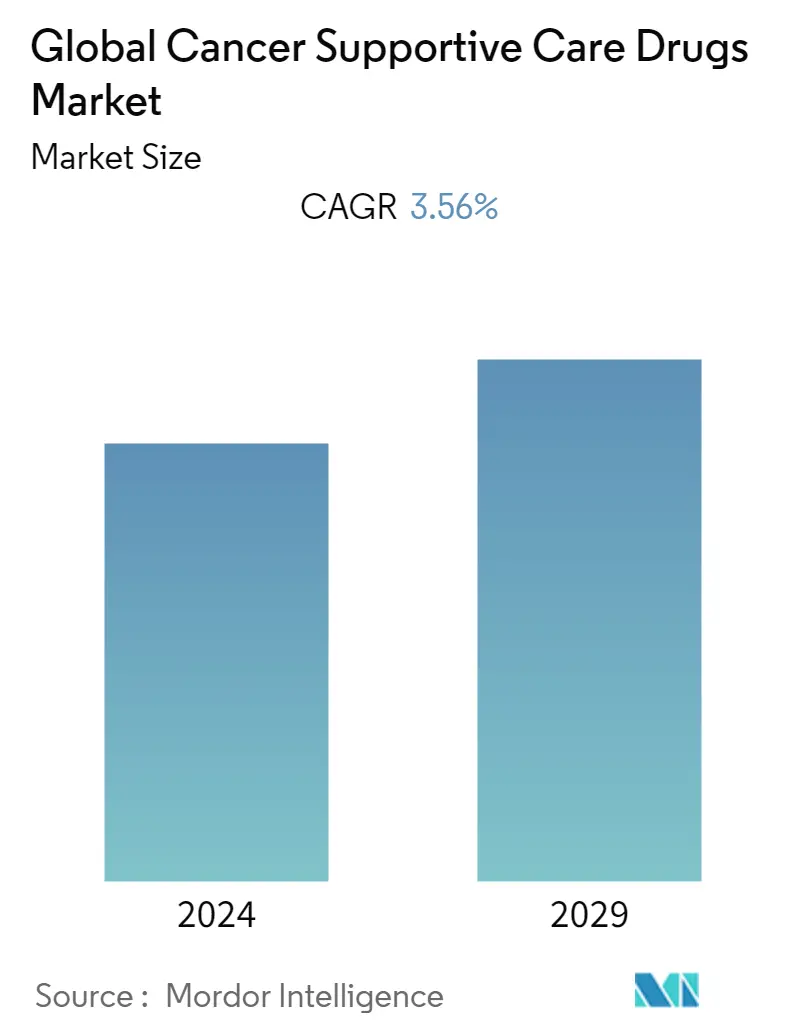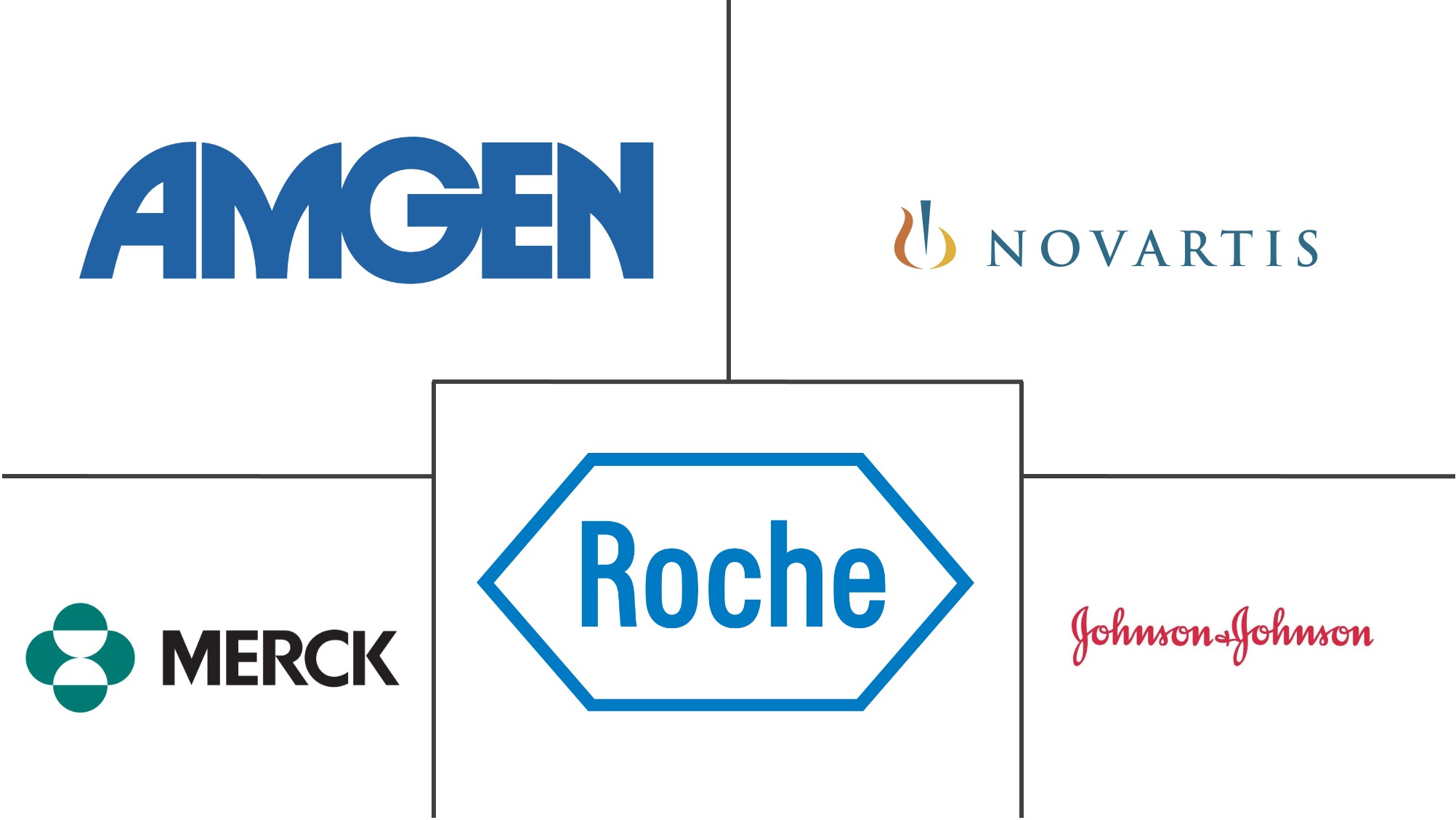Market Size of Global Cancer Supportive Care Drugs Industry

| Study Period | 2019 - 2029 |
| Base Year For Estimation | 2023 |
| CAGR | 3.56 % |
| Fastest Growing Market | Asia Pacific |
| Largest Market | North America |
| Market Concentration | Medium |
Major Players
*Disclaimer: Major Players sorted in no particular order |
Need a report that reflects how COVID-19 has impacted this market and its growth?
Cancer Supportive Care Drugs Market Analysis
The cancer supportive care drugs market is expected to register a CAGR of nearly 3.56% during the forecast period (2022-2027).
The COVID-19 pandemic affected healthcare systems and resulted in the interruption of usual care in many healthcare facilities, exposing vulnerable patients with cancer to significant risks. For Instance, in August 2020 the Authorea Journal article titled 'The Impact of COVID-19 Pandemic In Children With Cancer: A Report From Saudi Arabia' reported that cancer children on chemotherapy require regular outpatient assistance, and intermittent hospital admission, and support therapy for appropriate therapy delivery. It reported that in the studied population, 63% of patients reported a delay in treatment received during the COVID-19 pandemic. Also, out of these, the majority of patients (53.3%) reported hospital cancellation as the main reason for treatment or procedure delay during the COVID-19 lockdown and city curfew and 30.8% of patients reported non -availability of adequate PPE, lack of cancer support and shortage of medications as a major challenge faced during the pandemic. Many countries have suspended cancer screening programs for asymptomatic people due to the need to deploy healthcare personnel and resources to combat the pandemic. The Welsh and Scottish governments terminated breast, cervical, and bowel cancer screening programs in March 2020. Thus, owing to the shifted focus of research towards the development of COVID-19 vaccines, the market initially suffered a negative impact in terms of clinical trial activity but later came to recover.
Factors such as the increasing prevalence of cancer can be directly associated with the growth of this market. According to the American Cancer Society, in 2021 the estimated new numbers of cancer cases were 1.9 million and 608,570 cancer deaths in the United States. And in 2022 the same source projected that the new number of cancer cases will be 1.9 million and 609,360 cancer deaths in the United States. According to GLOBOCAN 2021, the new cancer cases that were diagnosed accounted for 19.3 million in 2021 globally, with 10.0 million deaths due to cancer. According to the WHO-World Health Organization, Cancer is the largest cause of mortality worldwide, accounting for almost 10 million fatalities in 2020, or nearly one in every six deaths, and approximately 400 000 children are diagnosed with the disease. Thus, increasing cancer would increase the demand for supportive drugs for treatment.
Rising disposable income and improved healthcare structure have also helped people to access cancer supportive care drugs, which is also helping this market grow. As per an August 2021 update, in Singapore, MediShield Life coverage changed from USD 3,000 a month to a range of USD 200 to USD 9,600 a month, based on the drugs used. The Government will also subsidize more cancer treatments and raise the criteria from a per capita monthly income of USD 2,800 to USD 6,500 for subsidies under the Medication Assistance Fund for certain high-cost drugs. The market players joining the patient access programs are boosting the growth of the market. For Instance, in February 2021, Biocon Biologics Ltd. signed an agreement with the Clinton Health Access Initiative (CHAI) to expand access to lifesaving cancer biosimilars in over 30 countries in Africa and Asia as a part of the Cancer Access Partnership (CAP). The partnership is a significant step in delivering advanced cancer therapies to patients who need them the most and ensuring equitable access to high-quality biosimilars in low- and middle-income countries (LMICs). Through this partnership, the company will enable access to Trastuzumab & Pegfilgrastim in Africa & Asia. The launch of new drugs by the market players in the regions is also boosting the growth of the market. For instance, in September 2021, Intas Pharmaceuticals launched Oral Azacitidine in India under the brand name Azadine-O for Acute Myeloid Leukemia. It is approved for use in maintenance therapy for adult patients with Acute Myeloid Leukaemia. Such launches enhance the accessibility of cancer-supportive drugs and thus boosts the growth of the market segment.
However, other factors such as side effects from cancer-supportive drugs and stringent regulatory processes have also contributed as restraining factors to this market.
Cancer Supportive Care Drugs Industry Segmentation
Cancer supportive care drugs are used to mitigate the harmful side effects of cancer treatment by protecting certain cells or organs. The cancer supportive care drugs market is segmented by Drug Class (Granulocyte colony-stimulating factor, Erythropoiesis stimulating agent, Antiemetics, Bisphosphonates, Opioids, Non Steroidal Anti-Inflammatory Drugs, Topical, and Others), and Geography (North America, Europe, Asia-Pacific, Middle East and Africa, and South America). The market report also covers the estimated market sizes and trends for 17 different countries across major regions, globally. The report offers the value (in USD million) for the above segments.
| By Drug Class | |
| G-CSFs (Granulocyte colony-stimulating factor) | |
| ESAs (Erythropoiesis stimulating agent) | |
| Antiemetics | |
| Bisphosphonates | |
| Opioids | |
| NSAIDs (Non Steroidal Anti-Inflammatory Drugs) | |
| Topical | |
| Others |
| Geography | ||||||||
| ||||||||
| ||||||||
| ||||||||
| ||||||||
|
Global Cancer Supportive Care Drugs Market Size Summary
The cancer supportive care drugs market is poised for growth, driven by the increasing prevalence of cancer globally. The market has shown resilience despite challenges posed by the COVID-19 pandemic, which disrupted healthcare services and delayed cancer treatments. The pandemic highlighted the vulnerabilities in cancer care, but the subsequent recovery and focus on supportive therapies have set the stage for market expansion. Factors such as rising disposable incomes, improved healthcare infrastructure, and strategic partnerships among market players are contributing to the market's growth. Initiatives like the Cancer Access Partnership and the introduction of new drugs in various regions are enhancing the accessibility of cancer supportive care drugs, further propelling market development.
North America is expected to maintain a significant share of the market, supported by robust healthcare systems and substantial investments in oncology research. The region's market growth is bolstered by innovative studies and collaborations aimed at advancing cancer treatment methodologies. The competitive landscape is characterized by the presence of major global players, with emerging companies in the Asia-Pacific region adding to the market dynamics. Regulatory approvals and clinical trials for new therapies continue to drive market activity, as seen with recent developments involving key players like Amgen Inc., Novartis AG, and Merck & Co. Inc. These factors collectively underscore the market's potential for continued expansion in the coming years.
Global Cancer Supportive Care Drugs Market Size - Table of Contents
-
1. MARKET DYNAMICS
-
1.1 Market Overview
-
1.2 Market Drivers
-
1.2.1 Large Number of Side-effects Associated with Cancer Treatment
-
1.2.2 Rising Disposable Incomes and Constant Improvements in Healthcare Infrastructure
-
1.2.3 Increasing Prevalence of Cancer
-
-
1.3 Market Restraints
-
1.3.1 Advancements in Targated Therapy Drugs
-
1.3.2 Side Effects of Supportive Care Drugs
-
1.3.3 Stringent Regulatory Process
-
-
1.4 Porter's Five Force Analysis
-
1.4.1 Threat of New Entrants
-
1.4.2 Bargaining Power of Buyers/Consumers
-
1.4.3 Bargaining Power of Suppliers
-
1.4.4 Threat of Substitute Products
-
1.4.5 Intensity of Competitive Rivalry
-
-
-
2. MARKET SEGMENTATION (Market Size by Value - USD million)
-
2.1 By Drug Class
-
2.1.1 G-CSFs (Granulocyte colony-stimulating factor)
-
2.1.2 ESAs (Erythropoiesis stimulating agent)
-
2.1.3 Antiemetics
-
2.1.4 Bisphosphonates
-
2.1.5 Opioids
-
2.1.6 NSAIDs (Non Steroidal Anti-Inflammatory Drugs)
-
2.1.7 Topical
-
2.1.8 Others
-
-
2.2 Geography
-
2.2.1 North America
-
2.2.1.1 United States
-
2.2.1.2 Canada
-
2.2.1.3 Mexico
-
-
2.2.2 Europe
-
2.2.2.1 Germany
-
2.2.2.2 United Kingdom
-
2.2.2.3 France
-
2.2.2.4 Italy
-
2.2.2.5 Spain
-
2.2.2.6 Rest of Europe
-
-
2.2.3 Asia-Pacific
-
2.2.3.1 China
-
2.2.3.2 Japan
-
2.2.3.3 India
-
2.2.3.4 Australia
-
2.2.3.5 South Korea
-
2.2.3.6 Rest of Asia-Pacific
-
-
2.2.4 Middle East and Africa
-
2.2.4.1 GCC
-
2.2.4.2 South Africa
-
2.2.4.3 Rest of Middle East and Africa
-
-
2.2.5 South America
-
2.2.5.1 Brazil
-
2.2.5.2 Argentina
-
2.2.5.3 Rest of South America
-
-
-
Global Cancer Supportive Care Drugs Market Size FAQs
What is the current Global Cancer Supportive Care Drugs Market size?
The Global Cancer Supportive Care Drugs Market is projected to register a CAGR of 3.56% during the forecast period (2024-2029)
Who are the key players in Global Cancer Supportive Care Drugs Market?
Amgen Inc., Novartis AG, Merck & Co. Inc, Johnson & Johnson and F. Hoffmann-La Roche AG are the major companies operating in the Global Cancer Supportive Care Drugs Market.

